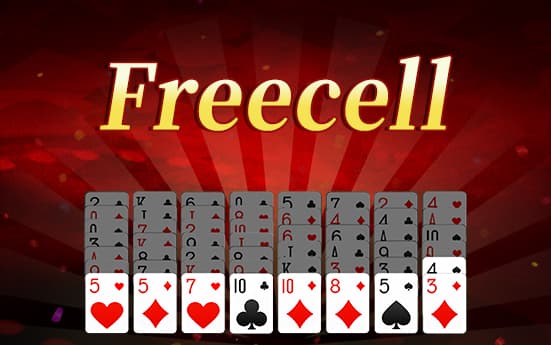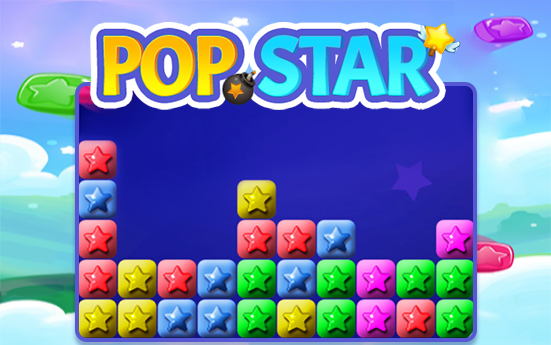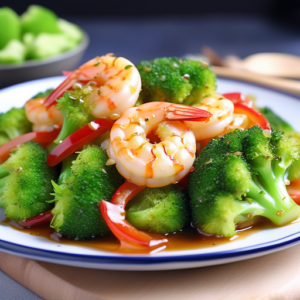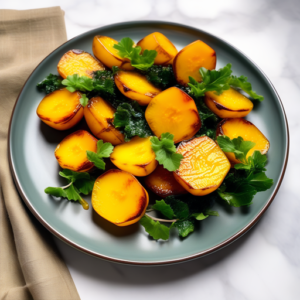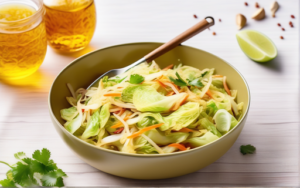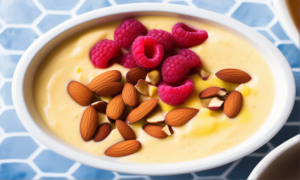 Low-Calorie Mango-Almond Smoothie Bowl
Indulge in a delicious and nutritious treat with our Mango-Almond Smoothie Bowl. Packed with flavor and goodness, this recipe ensures a satisfying experience while keeping the calorie count in check. Enjoy the thick, creamy, and frosty texture without any guilt.
Ingredients:
½ cup frozen chopped mango
½ cup nonfat plain Greek yogurt
¼ cup frozen sliced banana
¼ cup plain unsweetened almond milk
5 tablespoons unsalted almonds, divided
⅛ teaspoon ground allspice
¼ cup raspberries
½ teaspoon honey
Directions:
Blend mango, yogurt, banana, almond milk, 3 tablespoons almonds, and allspice in a blender until very smooth.
Pour the smoothie into a bowl and top with raspberries, the remaining 2 tablespoons almonds, and honey.
Low-Calorie Note:Delight in the luscious Mango-Almond Smoothie Bowl without compromising your calorie goals. This recipe offers a guilt-free option for a wholesome and flavorful breakfast or snack.
Low-Calorie Mango-Almond Smoothie Bowl
Indulge in a delicious and nutritious treat with our Mango-Almond Smoothie Bowl. Packed with flavor and goodness, this recipe ensures a satisfying experience while keeping the calorie count in check. Enjoy the thick, creamy, and frosty texture without any guilt.
Ingredients:
½ cup frozen chopped mango
½ cup nonfat plain Greek yogurt
¼ cup frozen sliced banana
¼ cup plain unsweetened almond milk
5 tablespoons unsalted almonds, divided
⅛ teaspoon ground allspice
¼ cup raspberries
½ teaspoon honey
Directions:
Blend mango, yogurt, banana, almond milk, 3 tablespoons almonds, and allspice in a blender until very smooth.
Pour the smoothie into a bowl and top with raspberries, the remaining 2 tablespoons almonds, and honey.
Low-Calorie Note:Delight in the luscious Mango-Almond Smoothie Bowl without compromising your calorie goals. This recipe offers a guilt-free option for a wholesome and flavorful breakfast or snack.
 Low-Calorie Huevos Rancheros Tacos
Enjoy the fusion of Tex-Mex flavors in a guilt-free manner with our Huevos Rancheros Tacos. Whether it's breakfast, brunch, lunch, or dinner, these Tacos Rancheros bring together the classic taste of tacos and the goodness of eggs. Indulge in this savory delight without the worry of excess calories.
Ingredients:
2 teaspoons olive oil
½ cup chopped red onion (1 medium)
2 cloves garlic, minced
1 (15-ounce) can no-salt-added pinto beans, drained
½ teaspoon ground cumin
¼ teaspoon kosher salt
¼ teaspoon dried oregano, crushed
⅛ teaspoon cayenne pepper
½ cup water
Nonstick cooking spray
3 eggs
9 egg whites
8 6-inch corn tortillas, warmed
½ cup shredded reduced-fat Colby and Monterey Jack cheese (2 ounces)
½ cup refrigerated pico de gallo
Directions:
In a 10-inch nonstick skillet, heat oil over medium. Add onion; cook about 4 minutes or until softened. Add garlic; cook for an additional 30 seconds. Remove from heat.
Stir beans, cumin, salt, oregano, and cayenne pepper into the onion mixture; mash with the back of a spoon. Return to heat, add water, and continue mashing. Simmer until beans reach a thick, spreadable consistency. Remove from skillet; keep warm.
Rinse and dry the skillet; coat with cooking spray. Heat the skillet over medium.
In a large bowl, whisk together eggs and egg whites. Add the egg mixture to the skillet and cook without stirring until eggs begin to set on the bottom and around edges. Lift and fold the partially cooked egg mixture with a spatula, allowing the uncooked portion to flow underneath. Continue cooking 2 to 3 minutes or until cooked through but still glossy and moist.
To serve, spread bean mixture on warmed tortillas; top with cooked eggs. Sprinkle with cheese, fold in half, and garnish with pico de gallo.
Low-Calorie Note: Revel in the vibrant flavors of these Huevos Rancheros Tacos without the calorie concerns. A wholesome and satisfying option for those mindful of their calorie intake.
Low-Calorie Huevos Rancheros Tacos
Enjoy the fusion of Tex-Mex flavors in a guilt-free manner with our Huevos Rancheros Tacos. Whether it's breakfast, brunch, lunch, or dinner, these Tacos Rancheros bring together the classic taste of tacos and the goodness of eggs. Indulge in this savory delight without the worry of excess calories.
Ingredients:
2 teaspoons olive oil
½ cup chopped red onion (1 medium)
2 cloves garlic, minced
1 (15-ounce) can no-salt-added pinto beans, drained
½ teaspoon ground cumin
¼ teaspoon kosher salt
¼ teaspoon dried oregano, crushed
⅛ teaspoon cayenne pepper
½ cup water
Nonstick cooking spray
3 eggs
9 egg whites
8 6-inch corn tortillas, warmed
½ cup shredded reduced-fat Colby and Monterey Jack cheese (2 ounces)
½ cup refrigerated pico de gallo
Directions:
In a 10-inch nonstick skillet, heat oil over medium. Add onion; cook about 4 minutes or until softened. Add garlic; cook for an additional 30 seconds. Remove from heat.
Stir beans, cumin, salt, oregano, and cayenne pepper into the onion mixture; mash with the back of a spoon. Return to heat, add water, and continue mashing. Simmer until beans reach a thick, spreadable consistency. Remove from skillet; keep warm.
Rinse and dry the skillet; coat with cooking spray. Heat the skillet over medium.
In a large bowl, whisk together eggs and egg whites. Add the egg mixture to the skillet and cook without stirring until eggs begin to set on the bottom and around edges. Lift and fold the partially cooked egg mixture with a spatula, allowing the uncooked portion to flow underneath. Continue cooking 2 to 3 minutes or until cooked through but still glossy and moist.
To serve, spread bean mixture on warmed tortillas; top with cooked eggs. Sprinkle with cheese, fold in half, and garnish with pico de gallo.
Low-Calorie Note: Revel in the vibrant flavors of these Huevos Rancheros Tacos without the calorie concerns. A wholesome and satisfying option for those mindful of their calorie intake.
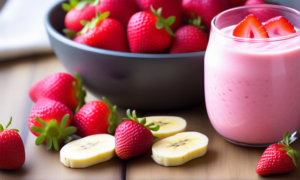 Low-Calorie Strawberry-Banana Protein Smoothie
Indulge in a delicious and low-calorie treat with our Strawberry-Banana Protein Smoothie. Packed with protein from Greek yogurt and nut butter, along with the added benefits of omega-3s from ground flaxseed, this smoothie is a nutritious delight. Whether you prefer a frosty texture with ice cubes or a milder temperature with water, this recipe offers flexibility to suit your taste.
Ingredients:
1 cup hulled strawberries, fresh or frozen
½ medium banana
½ cup diced mango, fresh or frozen
½ cup nonfat plain Greek yogurt
1 tablespoon natural nut butter, such as cashew or almond
1 tablespoon ground flaxseed (flaxmeal)
¼ teaspoon vanilla extract
4 ice cubes or ½ cup water
Directions:
Combine strawberries, banana, mango, yogurt, nut butter, flaxmeal, vanilla, and ice cubes (or water) in a blender.
Puree until smooth.
Low-Calorie Note: Savor the rich flavors of this Strawberry-Banana Protein Smoothie without worrying about excess calories. Packed with wholesome ingredients, it's a guilt-free option for a satisfying and nutritious beverage.
Low-Calorie Strawberry-Banana Protein Smoothie
Indulge in a delicious and low-calorie treat with our Strawberry-Banana Protein Smoothie. Packed with protein from Greek yogurt and nut butter, along with the added benefits of omega-3s from ground flaxseed, this smoothie is a nutritious delight. Whether you prefer a frosty texture with ice cubes or a milder temperature with water, this recipe offers flexibility to suit your taste.
Ingredients:
1 cup hulled strawberries, fresh or frozen
½ medium banana
½ cup diced mango, fresh or frozen
½ cup nonfat plain Greek yogurt
1 tablespoon natural nut butter, such as cashew or almond
1 tablespoon ground flaxseed (flaxmeal)
¼ teaspoon vanilla extract
4 ice cubes or ½ cup water
Directions:
Combine strawberries, banana, mango, yogurt, nut butter, flaxmeal, vanilla, and ice cubes (or water) in a blender.
Puree until smooth.
Low-Calorie Note: Savor the rich flavors of this Strawberry-Banana Protein Smoothie without worrying about excess calories. Packed with wholesome ingredients, it's a guilt-free option for a satisfying and nutritious beverage.
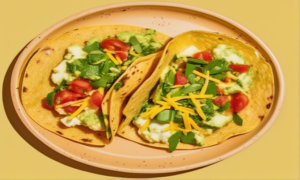 Low-Calorie Spinach & Egg Tacos
Enjoy a light and nutritious breakfast with these low-calorie Spinach & Egg Tacos. Hard-boiled eggs, spinach, cheese, and salsa come together in a flavorful combination. Mashed avocado adds creaminess, while a splash of lime juice brings a refreshing acidity. This quick and easy recipe is perfect for a satisfying start to your day.
Ingredients:
¼ avocado
1 teaspoon lime juice
2 hard-boiled eggs, chopped
2 corn tortillas, warmed
1 cup chopped spinach, divided
2 tablespoons shredded Cheddar cheese, divided
2 tablespoons salsa, divided
Directions:
In a small bowl, mash avocado with lime juice and salt.
Mix in chopped eggs.
Divide the avocado and egg mixture between warmed tortillas.
Top each taco with 1/2 cup spinach and 1 tablespoon each of shredded Cheddar cheese and salsa.
Low-Calorie Note: Delight in the flavors of these Spinach & Egg Tacos without compromising on your calorie goals. Packed with protein and veggies, it's a wholesome and satisfying breakfast option.
Low-Calorie Spinach & Egg Tacos
Enjoy a light and nutritious breakfast with these low-calorie Spinach & Egg Tacos. Hard-boiled eggs, spinach, cheese, and salsa come together in a flavorful combination. Mashed avocado adds creaminess, while a splash of lime juice brings a refreshing acidity. This quick and easy recipe is perfect for a satisfying start to your day.
Ingredients:
¼ avocado
1 teaspoon lime juice
2 hard-boiled eggs, chopped
2 corn tortillas, warmed
1 cup chopped spinach, divided
2 tablespoons shredded Cheddar cheese, divided
2 tablespoons salsa, divided
Directions:
In a small bowl, mash avocado with lime juice and salt.
Mix in chopped eggs.
Divide the avocado and egg mixture between warmed tortillas.
Top each taco with 1/2 cup spinach and 1 tablespoon each of shredded Cheddar cheese and salsa.
Low-Calorie Note: Delight in the flavors of these Spinach & Egg Tacos without compromising on your calorie goals. Packed with protein and veggies, it's a wholesome and satisfying breakfast option.
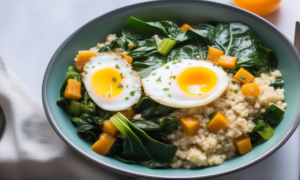 Low-Calorie Savory Oatmeal with Cheddar, Collards & Eggs
Indulge in the savory side of oats with this delicious and low-calorie recipe. Experience a delightful twist to the usual sweet oatmeal by incorporating a generous serving of vegetables. Savor the combination of Cheddar, collards, and eggs, creating a wholesome meal. Spice it up with hot sauce for an extra kick, if desired.
Ingredients:
2 tablespoons extra-virgin olive oil, divided
2 tablespoons diced shallot
2 cups rolled oats (see Tip)
4 cups water plus 1/2 cup, divided
½ teaspoon salt, divided
½ teaspoon ground pepper, divided
10 cups chopped collard greens (from 1-2 bunches)
2 teaspoons red-wine vinegar
1 cup shredded Cheddar cheese
¼ cup chipotle salsa, plus more for serving
4 large eggs, cooked as desired
Directions:
Heat 1 tablespoon oil in a large saucepan over medium heat. Add shallot and cook until softened, 1 to 2 minutes. Stir in oats and cook for an additional 1 minute. Add 4 cups water, 1/4 teaspoon salt, and 1/4 teaspoon pepper. Bring to a boil, then simmer until creamy, 10 to 12 minutes.
In a large skillet, heat the remaining 1 tablespoon oil over medium-high heat. Add collards, 1/2 cup water, 1/4 teaspoon salt, and 1/4 teaspoon pepper. Cook until tender, 5 to 7 minutes. Remove from heat and stir in vinegar.
Stir cheese and salsa into the oatmeal. Serve with collards, eggs, and additional salsa, if desired.
Low-Calorie Note: Relish the savory goodness of this oatmeal while keeping your calorie intake in check. Packed with vegetables, Cheddar, and eggs, it's a balanced and flavorful option for a satisfying meal.
Low-Calorie Savory Oatmeal with Cheddar, Collards & Eggs
Indulge in the savory side of oats with this delicious and low-calorie recipe. Experience a delightful twist to the usual sweet oatmeal by incorporating a generous serving of vegetables. Savor the combination of Cheddar, collards, and eggs, creating a wholesome meal. Spice it up with hot sauce for an extra kick, if desired.
Ingredients:
2 tablespoons extra-virgin olive oil, divided
2 tablespoons diced shallot
2 cups rolled oats (see Tip)
4 cups water plus 1/2 cup, divided
½ teaspoon salt, divided
½ teaspoon ground pepper, divided
10 cups chopped collard greens (from 1-2 bunches)
2 teaspoons red-wine vinegar
1 cup shredded Cheddar cheese
¼ cup chipotle salsa, plus more for serving
4 large eggs, cooked as desired
Directions:
Heat 1 tablespoon oil in a large saucepan over medium heat. Add shallot and cook until softened, 1 to 2 minutes. Stir in oats and cook for an additional 1 minute. Add 4 cups water, 1/4 teaspoon salt, and 1/4 teaspoon pepper. Bring to a boil, then simmer until creamy, 10 to 12 minutes.
In a large skillet, heat the remaining 1 tablespoon oil over medium-high heat. Add collards, 1/2 cup water, 1/4 teaspoon salt, and 1/4 teaspoon pepper. Cook until tender, 5 to 7 minutes. Remove from heat and stir in vinegar.
Stir cheese and salsa into the oatmeal. Serve with collards, eggs, and additional salsa, if desired.
Low-Calorie Note: Relish the savory goodness of this oatmeal while keeping your calorie intake in check. Packed with vegetables, Cheddar, and eggs, it's a balanced and flavorful option for a satisfying meal.
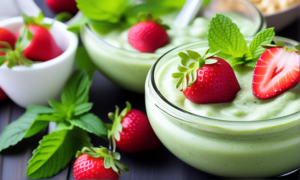 Low-Calorie Strawberry-Banana Green Smoothie Recipe
Enjoy a burst of freshness with this low-calorie strawberry-banana green smoothie. Sweetened only with fruit, this delightful smoothie packs a nutritious punch with the added goodness of omega-3s from flaxseeds. Sip on this green goodness for a guilt-free and refreshing treat.
Ingredients:
1 medium banana
1 cup baby spinach
½ cup low-fat plain Greek yogurt
½ cup nonfat milk
6 frozen strawberries
1 tablespoon flaxseeds
Directions:
Puree banana, spinach, yogurt, milk, strawberries, and flaxseeds in a blender until smooth.
Low-Calorie Note: Indulge in the vibrant flavors of this strawberry-banana green smoothie without worrying about excess calories. With a perfect blend of spinach, yogurt, and the natural sweetness of fruits, it's a nutrient-packed, low-calorie option for a healthy start to your day.
Low-Calorie Strawberry-Banana Green Smoothie Recipe
Enjoy a burst of freshness with this low-calorie strawberry-banana green smoothie. Sweetened only with fruit, this delightful smoothie packs a nutritious punch with the added goodness of omega-3s from flaxseeds. Sip on this green goodness for a guilt-free and refreshing treat.
Ingredients:
1 medium banana
1 cup baby spinach
½ cup low-fat plain Greek yogurt
½ cup nonfat milk
6 frozen strawberries
1 tablespoon flaxseeds
Directions:
Puree banana, spinach, yogurt, milk, strawberries, and flaxseeds in a blender until smooth.
Low-Calorie Note: Indulge in the vibrant flavors of this strawberry-banana green smoothie without worrying about excess calories. With a perfect blend of spinach, yogurt, and the natural sweetness of fruits, it's a nutrient-packed, low-calorie option for a healthy start to your day.
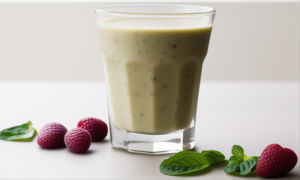 Low-Calorie Peanut Butter & Jelly Smoothie Recipe
Indulge in the classic PB & J flavors without the guilt with this low-calorie peanut butter and jelly smoothie. Packed with nutritious ingredients like Greek yogurt, spinach, and strawberries, this protein-rich smoothie is a healthy and delicious alternative to the traditional sandwich. Skip the bread and savor the goodness in every sip of this satisfying smoothie.
Ingredients:
½ cup low-fat milk
⅓ cup nonfat plain Greek yogurt
1 cup baby spinach
1 cup frozen banana slices (about 1 medium banana)
½ cup frozen strawberries
1 tablespoon natural peanut butter
1-2 teaspoons pure maple syrup or honey (optional)
Directions:
Add milk and yogurt to a blender, then add spinach, banana, strawberries, peanut butter, and sweetener (if using); blend until smooth.
Low-Calorie Note: This peanut butter and jelly smoothie is not just a tasty treat but also a low-calorie delight. With the richness of peanut butter, the freshness of spinach, and the sweetness of strawberries, it's a wholesome, protein-packed smoothie without the excess calories. Enjoy the classic combination in a healthier form.
Low-Calorie Peanut Butter & Jelly Smoothie Recipe
Indulge in the classic PB & J flavors without the guilt with this low-calorie peanut butter and jelly smoothie. Packed with nutritious ingredients like Greek yogurt, spinach, and strawberries, this protein-rich smoothie is a healthy and delicious alternative to the traditional sandwich. Skip the bread and savor the goodness in every sip of this satisfying smoothie.
Ingredients:
½ cup low-fat milk
⅓ cup nonfat plain Greek yogurt
1 cup baby spinach
1 cup frozen banana slices (about 1 medium banana)
½ cup frozen strawberries
1 tablespoon natural peanut butter
1-2 teaspoons pure maple syrup or honey (optional)
Directions:
Add milk and yogurt to a blender, then add spinach, banana, strawberries, peanut butter, and sweetener (if using); blend until smooth.
Low-Calorie Note: This peanut butter and jelly smoothie is not just a tasty treat but also a low-calorie delight. With the richness of peanut butter, the freshness of spinach, and the sweetness of strawberries, it's a wholesome, protein-packed smoothie without the excess calories. Enjoy the classic combination in a healthier form.
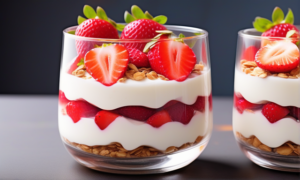 Low-Calorie Strawberry & Yogurt Parfait Recipe
Indulge in a guilt-free breakfast with this delightful low-calorie strawberry parfait. Combining fresh fruit, creamy Greek yogurt, and crunchy granola, this easy-to-make parfait is not only delicious but also a healthy choice. Perfect for a breakfast on the go, pack this delightful treat in a Mason jar and savor the goodness of a nutritious start to your day.
Ingredients:
1 cup sliced fresh strawberries
1 teaspoon sugar
½ cup nonfat plain Greek yogurt
¼ cup granola
Directions:
Combine strawberries and sugar in a small bowl and let stand until the berries start to release juice, about 5 minutes.
To assemble the parfait, layer yogurt and the strawberries with their juice in a 2-cup container.
Top with granola.
Low-Calorie Note: This strawberry and yogurt parfait is not only delicious but also a low-calorie breakfast option. Packed with the goodness of fresh strawberries, protein-rich Greek yogurt, and a touch of granola for crunch, it's a satisfying choice without the extra calories. Enjoy the sweetness of strawberries and the creaminess of yogurt guilt-free.
Low-Calorie Strawberry & Yogurt Parfait Recipe
Indulge in a guilt-free breakfast with this delightful low-calorie strawberry parfait. Combining fresh fruit, creamy Greek yogurt, and crunchy granola, this easy-to-make parfait is not only delicious but also a healthy choice. Perfect for a breakfast on the go, pack this delightful treat in a Mason jar and savor the goodness of a nutritious start to your day.
Ingredients:
1 cup sliced fresh strawberries
1 teaspoon sugar
½ cup nonfat plain Greek yogurt
¼ cup granola
Directions:
Combine strawberries and sugar in a small bowl and let stand until the berries start to release juice, about 5 minutes.
To assemble the parfait, layer yogurt and the strawberries with their juice in a 2-cup container.
Top with granola.
Low-Calorie Note: This strawberry and yogurt parfait is not only delicious but also a low-calorie breakfast option. Packed with the goodness of fresh strawberries, protein-rich Greek yogurt, and a touch of granola for crunch, it's a satisfying choice without the extra calories. Enjoy the sweetness of strawberries and the creaminess of yogurt guilt-free.
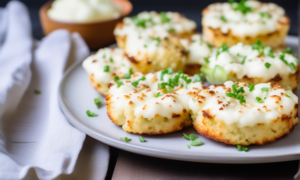 Low-Calorie Cauliflower English Muffins Recipe
Indulge in a guilt-free breakfast with these savory and gluten-free cauliflower English muffins. Using cauliflower instead of flour, these muffins are bound together with a hint of cheese and egg, making them a delicious grain-free alternative. Top them with sweet jam or assemble a tasty breakfast sandwich for a wholesome start to your day.
Ingredients:
5 cups cauliflower florets (about 1 pound)
1 cup shredded sharp Cheddar cheese
1 large egg, lightly beaten
⅛ teaspoon salt
Directions:
Preheat oven to 425 degrees F. Line a large baking sheet with parchment paper.
Place cauliflower in a food processor and process until finely grated.
Transfer the cauliflower to a microwave-safe bowl, cover loosely, and microwave on High for 3 minutes. Let it cool slightly.
Transfer the cauliflower to a clean kitchen towel, wring out excess moisture, and return it to the bowl.
Stir in Cheddar, egg, and salt until thoroughly combined.
Place a 3-inch biscuit cutter on the prepared baking sheet. Fill the cutter with about 1/4 cup of the batter, patting down slightly in the mold.
Repeat with the remaining batter, leaving about 1 inch between each one, until you have 8 "muffins."
Bake until browned and crispy around the edges, about 25 minutes.
Serve with your favorite toppings or use them to make a delightful breakfast sandwich.
Low-Calorie Note: These cauliflower English muffins are a waistline-friendly choice, offering a satisfying breakfast option with fewer calories. Enjoy a delicious and nutritious start to your day without compromising on flavor.
Low-Calorie Cauliflower English Muffins Recipe
Indulge in a guilt-free breakfast with these savory and gluten-free cauliflower English muffins. Using cauliflower instead of flour, these muffins are bound together with a hint of cheese and egg, making them a delicious grain-free alternative. Top them with sweet jam or assemble a tasty breakfast sandwich for a wholesome start to your day.
Ingredients:
5 cups cauliflower florets (about 1 pound)
1 cup shredded sharp Cheddar cheese
1 large egg, lightly beaten
⅛ teaspoon salt
Directions:
Preheat oven to 425 degrees F. Line a large baking sheet with parchment paper.
Place cauliflower in a food processor and process until finely grated.
Transfer the cauliflower to a microwave-safe bowl, cover loosely, and microwave on High for 3 minutes. Let it cool slightly.
Transfer the cauliflower to a clean kitchen towel, wring out excess moisture, and return it to the bowl.
Stir in Cheddar, egg, and salt until thoroughly combined.
Place a 3-inch biscuit cutter on the prepared baking sheet. Fill the cutter with about 1/4 cup of the batter, patting down slightly in the mold.
Repeat with the remaining batter, leaving about 1 inch between each one, until you have 8 "muffins."
Bake until browned and crispy around the edges, about 25 minutes.
Serve with your favorite toppings or use them to make a delightful breakfast sandwich.
Low-Calorie Note: These cauliflower English muffins are a waistline-friendly choice, offering a satisfying breakfast option with fewer calories. Enjoy a delicious and nutritious start to your day without compromising on flavor.
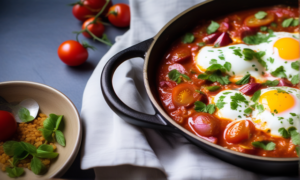 Low-Calorie Shakshuka (Eggs Poached in Spicy Tomato Sauce)
Indulge in a flavorful and low-calorie version of Shakshuka, a veggie-packed delight featuring poached eggs in a spicy blend of tomatoes, onions, peppers, and aromatic spices. Originating from North Africa and the Middle East, this dish is perfect for a satisfying breakfast or lunch.
Ingredients:
2 tablespoons olive oil
2 cups chopped red sweet peppers
½ cup chopped onion
2 tablespoons no-salt-added tomato paste
1 teaspoon smoked paprika
2 teaspoons crushed red pepper
3 cups chopped tomatoes
1 teaspoon ground cumin
¼ teaspoon salt
4 eggs
½ cup plain low-fat Greek yogurt
Snipped fresh parsley
2 whole-wheat pita bread rounds, halved crosswise and warmed
Directions:
In a 10-inch skillet, heat olive oil over medium heat. Add the next five ingredients (through crushed red pepper). Cook for 5 to 7 minutes or until the onion is tender, stirring occasionally.
Stir in tomatoes, cumin, and salt. Bring to a boil; then reduce heat. Simmer for 10 minutes or until the tomatoes begin to break down.
Make four indentations in the tomato mixture. Break an egg into a custard cup or small bowl and slip it into an indentation. Repeat with the remaining three eggs. Simmer, covered, for 4 to 6 minutes or until the whites are completely set, and yolks begin to thicken but are not hard.
Top with yogurt and sprinkle with parsley. Serve with warm, halved whole-wheat pita bread rounds.
Low-Calorie Note:This Shakshuka recipe offers a deliciously satisfying experience with lower calorie content, making it an ideal choice for those looking to enjoy a flavorful meal while being mindful of their calorie intake.
Low-Calorie Shakshuka (Eggs Poached in Spicy Tomato Sauce)
Indulge in a flavorful and low-calorie version of Shakshuka, a veggie-packed delight featuring poached eggs in a spicy blend of tomatoes, onions, peppers, and aromatic spices. Originating from North Africa and the Middle East, this dish is perfect for a satisfying breakfast or lunch.
Ingredients:
2 tablespoons olive oil
2 cups chopped red sweet peppers
½ cup chopped onion
2 tablespoons no-salt-added tomato paste
1 teaspoon smoked paprika
2 teaspoons crushed red pepper
3 cups chopped tomatoes
1 teaspoon ground cumin
¼ teaspoon salt
4 eggs
½ cup plain low-fat Greek yogurt
Snipped fresh parsley
2 whole-wheat pita bread rounds, halved crosswise and warmed
Directions:
In a 10-inch skillet, heat olive oil over medium heat. Add the next five ingredients (through crushed red pepper). Cook for 5 to 7 minutes or until the onion is tender, stirring occasionally.
Stir in tomatoes, cumin, and salt. Bring to a boil; then reduce heat. Simmer for 10 minutes or until the tomatoes begin to break down.
Make four indentations in the tomato mixture. Break an egg into a custard cup or small bowl and slip it into an indentation. Repeat with the remaining three eggs. Simmer, covered, for 4 to 6 minutes or until the whites are completely set, and yolks begin to thicken but are not hard.
Top with yogurt and sprinkle with parsley. Serve with warm, halved whole-wheat pita bread rounds.
Low-Calorie Note:This Shakshuka recipe offers a deliciously satisfying experience with lower calorie content, making it an ideal choice for those looking to enjoy a flavorful meal while being mindful of their calorie intake.
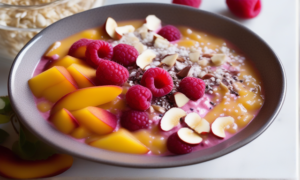 Raspberry-Peach-Mango Smoothie Bowl Recipe
Embark on a delicious journey with this Raspberry-Peach-Mango Smoothie Bowl, a nutritious and customizable delight that introduces you to the craze of smoothie bowls. Feel free to personalize it with your favorite fruits, nuts, and seeds to make it uniquely yours. Using frozen fruit in Step 1 ensures a lusciously creamy and frosty base for the delightful toppings.
Ingredients:
1 cup frozen mango chunks
¾ cup nonfat plain Greek yogurt
¼ cup reduced-fat milk
1 teaspoon vanilla extract
¼ ripe peach, sliced
⅓ cup raspberries
1 tablespoon sliced almonds, toasted if desired
1 tablespoon unsweetened coconut flakes, toasted if desired
1 teaspoon chia seeds
Directions:
Combine frozen mango, yogurt, milk, and vanilla in a blender. Puree until smooth.
Pour the smoothie into a bowl and artfully top it with sliced peach, raspberries, almonds, toasted coconut, and chia seeds according to your taste preferences.
Raspberry-Peach-Mango Smoothie Bowl Recipe
Embark on a delicious journey with this Raspberry-Peach-Mango Smoothie Bowl, a nutritious and customizable delight that introduces you to the craze of smoothie bowls. Feel free to personalize it with your favorite fruits, nuts, and seeds to make it uniquely yours. Using frozen fruit in Step 1 ensures a lusciously creamy and frosty base for the delightful toppings.
Ingredients:
1 cup frozen mango chunks
¾ cup nonfat plain Greek yogurt
¼ cup reduced-fat milk
1 teaspoon vanilla extract
¼ ripe peach, sliced
⅓ cup raspberries
1 tablespoon sliced almonds, toasted if desired
1 tablespoon unsweetened coconut flakes, toasted if desired
1 teaspoon chia seeds
Directions:
Combine frozen mango, yogurt, milk, and vanilla in a blender. Puree until smooth.
Pour the smoothie into a bowl and artfully top it with sliced peach, raspberries, almonds, toasted coconut, and chia seeds according to your taste preferences.
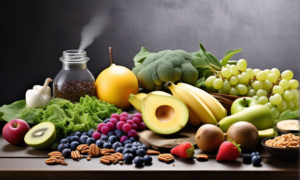 Debunking the Myth: Does High-Fiber Food Lead to Weight Gain? Insights from Nutritionists
Introduction:
There's a common misconception that consuming high-fiber foods can lead to weight gain, but the reality is quite the opposite. While fiber may not be the most glamorous nutrient, its significance in maintaining overall health cannot be overstated. Abundant in plant-based foods, dietary fiber is an indigestible carbohydrate that aids in maintaining a healthy digestive system, transporting LDL cholesterol away from the heart, promoting satiety, and regulating blood sugar levels. According to the Centers for Disease Control and Prevention (CDC), a fiber-rich diet is linked to reduced risks of heart disease, diabetes, and certain types of cancers.
For optimal health, it's encouraged to increase the intake of fiber-rich foods such as fruits, vegetables, nuts, seeds, legumes, and whole grains. However, does consuming fiber contribute to weight loss, or can overconsumption lead to weight gain?
This article will explore how fiber facilitates weight loss, why some may perceive it as a weight-gaining factor, the role of fiber supplements, and 10 simple ways to increase fiber intake.
Why Fiber Promotes Healthy Weight Loss:
Despite the numerous health benefits of fiber, the majority of Americans, as per the 2020-2025 Dietary Guidelines, fall short of the recommended daily fiber intake (25 to 34 grams). In addition to promoting heart health and a well-functioning digestive system, fiber has been proven to support healthy weight loss through various potential mechanisms.
Increased Satiety:Fiber induces a sense of fullness, requiring longer chewing time, stimulating saliva and gastric acid production, and slowing down stomach emptying. Prolonged satiety may lead to reduced overall calorie intake, creating a calorie deficit and resulting in weight loss. Research suggests that the impact of fiber on satiety depends on factors such as fiber quantity, molecular size, solubility, and the food matrix.
Supports Diet Adherence:In a 2019 study published in the Nutrition Journal, researchers found that dietary fiber intake, unrelated to nutrient and calorie intake, facilitated weight loss and adherence to diet restrictions in adults struggling with overweight or obesity.
Improves Gut Microbiota:Certain types of dietary fiber, known as prebiotics, can increase the presence of beneficial bacteria like bifidobacteria and lactobacilli in the gut. Diverse and healthy gut microbiota is associated with weight loss and reduced obesity risk, as highlighted in a 2017 review in Translational Medicine and a 2018 review in Genes.
Blood Sugar Regulation:Fiber plays a crucial role in slowing down the metabolism of glucose from carbohydrates, leading to a gradual and steady postprandial blood sugar response. This stable response is linked to increased satiety.
Why You Might Think Fiber Causes Weight Gain:
A sudden or significant increase in fiber intake, especially without sufficient water consumption, can lead to bloating, abdominal distension, and constipation. When your stomach feels bloated or your bowel movements are irregular, you might perceive a temporary weight gain due to fecal support affecting scale readings. However, sustained weight gain requires consuming more calories than your body needs.
Are Fiber Supplements Beneficial for Weight Loss?
While fiber supplements may contribute to increased fiber intake, they do not address other behavioral factors influencing weight, such as stress, sleep, physical activity, and dietary choices. Fiber supplements lack the diverse nutritional components present in whole foods, emphasizing the importance of a food-first approach for weight management. Additionally, the effectiveness of fiber supplements may vary among individuals.
10 Simple Ways to Increase Fiber Intake:
As per the Dietary Guidelines, adult women are recommended to consume 25 to 28 grams of fiber daily, while adult men should aim for 31 to 34 grams. For those not accustomed to consuming fiber-rich foods, gradually increasing intake while ensuring adequate water intake can minimize bloating and prevent constipation, nausea, and dehydration. Here are 10 practical ways to boost daily fiber consumption:
Start your day with a fiber-rich breakfast, such as vegetable omelets with whole-grain bread, low-fat yogurt with fruits and nuts, a fruit or vegetable high-protein smoothie, or fiber-rich overnight oats.
Add one serving of fruit or vegetables to each meal, aiming for 1.5 to 2 cups of fruit and 2 to 3 cups of vegetables daily for adults.
Consume fruit and vegetable skins, such as apples, pears, and potatoes.
Include one serving of berries in your daily diet; one cup of raspberries, for example, contains 8 grams of fiber.
Eat one serving (1 to 1.5 ounces) of nuts daily, which provide fiber and omega-3 fatty acids crucial for heart, eye, brain, and skin health.
Practice the USDA's MyPlate method, filling half your plate with non-starchy vegetables, one-quarter with protein sources (fish, chicken, turkey, lean beef, tofu), and the remaining quarter with starchy protein sources (whole grains or starchy vegetables like sweet potatoes, potatoes, pumpkin, or butternut squash).
Add a tablespoon of fiber-rich seeds to snacks, such as chia seeds, flaxseed powder, hemp seeds, or pumpkin seeds, in yogurt, cheese, oats, or non-dairy yogurt alternatives.
Choose whole grains for half of your grains, including whole-grain bread, whole wheat, oats, popcorn, corn, farro, freekeh, quinoa, barley, brown rice, wild rice, and teff.
Include half a cup of legumes in your daily routine; for example, mix chopped vegetables with hummus or chickpea puree. Half a cup of beans contains at least 5 grams of fiber.
Consume avocados in various forms, such as in top-tier sandwiches, vegetable bowls, wraps, or whole-grain crackers. According to USDA data, half a medium-sized avocado contains around 6 grams of fiber.
In conclusion, rather than causing weight gain, a well-rounded diet rich in fiber can significantly contribute to healthy weight loss and overall well-being. The key is to adopt a balanced and sustainable approach to dietary choices, embracing a variety of nutrient-dense foods.
Debunking the Myth: Does High-Fiber Food Lead to Weight Gain? Insights from Nutritionists
Introduction:
There's a common misconception that consuming high-fiber foods can lead to weight gain, but the reality is quite the opposite. While fiber may not be the most glamorous nutrient, its significance in maintaining overall health cannot be overstated. Abundant in plant-based foods, dietary fiber is an indigestible carbohydrate that aids in maintaining a healthy digestive system, transporting LDL cholesterol away from the heart, promoting satiety, and regulating blood sugar levels. According to the Centers for Disease Control and Prevention (CDC), a fiber-rich diet is linked to reduced risks of heart disease, diabetes, and certain types of cancers.
For optimal health, it's encouraged to increase the intake of fiber-rich foods such as fruits, vegetables, nuts, seeds, legumes, and whole grains. However, does consuming fiber contribute to weight loss, or can overconsumption lead to weight gain?
This article will explore how fiber facilitates weight loss, why some may perceive it as a weight-gaining factor, the role of fiber supplements, and 10 simple ways to increase fiber intake.
Why Fiber Promotes Healthy Weight Loss:
Despite the numerous health benefits of fiber, the majority of Americans, as per the 2020-2025 Dietary Guidelines, fall short of the recommended daily fiber intake (25 to 34 grams). In addition to promoting heart health and a well-functioning digestive system, fiber has been proven to support healthy weight loss through various potential mechanisms.
Increased Satiety:Fiber induces a sense of fullness, requiring longer chewing time, stimulating saliva and gastric acid production, and slowing down stomach emptying. Prolonged satiety may lead to reduced overall calorie intake, creating a calorie deficit and resulting in weight loss. Research suggests that the impact of fiber on satiety depends on factors such as fiber quantity, molecular size, solubility, and the food matrix.
Supports Diet Adherence:In a 2019 study published in the Nutrition Journal, researchers found that dietary fiber intake, unrelated to nutrient and calorie intake, facilitated weight loss and adherence to diet restrictions in adults struggling with overweight or obesity.
Improves Gut Microbiota:Certain types of dietary fiber, known as prebiotics, can increase the presence of beneficial bacteria like bifidobacteria and lactobacilli in the gut. Diverse and healthy gut microbiota is associated with weight loss and reduced obesity risk, as highlighted in a 2017 review in Translational Medicine and a 2018 review in Genes.
Blood Sugar Regulation:Fiber plays a crucial role in slowing down the metabolism of glucose from carbohydrates, leading to a gradual and steady postprandial blood sugar response. This stable response is linked to increased satiety.
Why You Might Think Fiber Causes Weight Gain:
A sudden or significant increase in fiber intake, especially without sufficient water consumption, can lead to bloating, abdominal distension, and constipation. When your stomach feels bloated or your bowel movements are irregular, you might perceive a temporary weight gain due to fecal support affecting scale readings. However, sustained weight gain requires consuming more calories than your body needs.
Are Fiber Supplements Beneficial for Weight Loss?
While fiber supplements may contribute to increased fiber intake, they do not address other behavioral factors influencing weight, such as stress, sleep, physical activity, and dietary choices. Fiber supplements lack the diverse nutritional components present in whole foods, emphasizing the importance of a food-first approach for weight management. Additionally, the effectiveness of fiber supplements may vary among individuals.
10 Simple Ways to Increase Fiber Intake:
As per the Dietary Guidelines, adult women are recommended to consume 25 to 28 grams of fiber daily, while adult men should aim for 31 to 34 grams. For those not accustomed to consuming fiber-rich foods, gradually increasing intake while ensuring adequate water intake can minimize bloating and prevent constipation, nausea, and dehydration. Here are 10 practical ways to boost daily fiber consumption:
Start your day with a fiber-rich breakfast, such as vegetable omelets with whole-grain bread, low-fat yogurt with fruits and nuts, a fruit or vegetable high-protein smoothie, or fiber-rich overnight oats.
Add one serving of fruit or vegetables to each meal, aiming for 1.5 to 2 cups of fruit and 2 to 3 cups of vegetables daily for adults.
Consume fruit and vegetable skins, such as apples, pears, and potatoes.
Include one serving of berries in your daily diet; one cup of raspberries, for example, contains 8 grams of fiber.
Eat one serving (1 to 1.5 ounces) of nuts daily, which provide fiber and omega-3 fatty acids crucial for heart, eye, brain, and skin health.
Practice the USDA's MyPlate method, filling half your plate with non-starchy vegetables, one-quarter with protein sources (fish, chicken, turkey, lean beef, tofu), and the remaining quarter with starchy protein sources (whole grains or starchy vegetables like sweet potatoes, potatoes, pumpkin, or butternut squash).
Add a tablespoon of fiber-rich seeds to snacks, such as chia seeds, flaxseed powder, hemp seeds, or pumpkin seeds, in yogurt, cheese, oats, or non-dairy yogurt alternatives.
Choose whole grains for half of your grains, including whole-grain bread, whole wheat, oats, popcorn, corn, farro, freekeh, quinoa, barley, brown rice, wild rice, and teff.
Include half a cup of legumes in your daily routine; for example, mix chopped vegetables with hummus or chickpea puree. Half a cup of beans contains at least 5 grams of fiber.
Consume avocados in various forms, such as in top-tier sandwiches, vegetable bowls, wraps, or whole-grain crackers. According to USDA data, half a medium-sized avocado contains around 6 grams of fiber.
In conclusion, rather than causing weight gain, a well-rounded diet rich in fiber can significantly contribute to healthy weight loss and overall well-being. The key is to adopt a balanced and sustainable approach to dietary choices, embracing a variety of nutrient-dense foods.
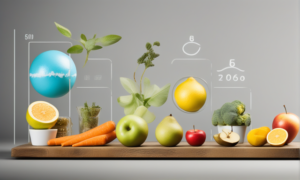 Breaking 5 Unhealthy Habits to Embark on an Effortless Weight Loss Journey
Introduction:
Obesity is not an overnight occurrence but a result of prolonged calorie surplus over time. To achieve weight loss goals, it is essential to boost metabolism, adjust dietary habits, and engage in adequate exercise to burn calories, allowing your body to gradually regain a healthy and vibrant physique.
1. Prolonged Sedentary Lifestyle and Aging of Body Functions
Sitting for extended periods can have various detrimental effects, such as compression of the spine leading to back issues, fatigue, joint hardening, and hindered lower limb circulation, resulting in undesirable body shapes. Combat these suboptimal health conditions by incorporating activities like squats, push-ups, or leg lifts every hour to promote calorie expenditure and maintain a youthful physique.
2. Late-Night Snacking
Consuming food before bedtime introduces extra calories, contributing to fat accumulation. For effective weight loss, it's recommended to have an early dinner, with a minimum 4-hour gap before sleep, promoting enhanced fat burning during rest.
3. Staying Up Late
Late nights may accelerate aging, hinder metabolism, and disrupt hormone secretion, contributing to weight gain. Adhering to a regular sleep schedule aids in hormone balance, maintaining a youthful physique, and ensuring a well-rested body and mind.
4. High Salt Intake
Foods rich in salt stimulate appetite, leading to increased calorie intake. Maintaining a balanced and low-sodium diet with a focus on vegetables and fruits is crucial for sculpting an ideal body shape.
5. Inactivity After Meals
While dietary control is vital, exercise plays an equally crucial role. Moderate physical activity not only boosts metabolic activity but also enhances overall physical fitness, contributing to a healthier weight loss journey. Starting with a half-hour routine and gradually increasing intensity and duration is an effective approach.
Dietary Tips:
Control food intake to avoid overeating.
Opt for low-fat cooking methods such as steaming, boiling, or baking to reduce fat consumption.
Increase fiber intake with whole grains, vegetables, and fruits to enhance satiety.
Avoid high-sugar, high-fat, and high-salt foods, opting for natural and healthy ingredients.
Conclusion:
By correcting unhealthy habits, adjusting dietary structures, and incorporating moderate exercise, achieving weight loss becomes a manageable journey. Focusing on a well-balanced diet and adopting healthy lifestyle habits not only enhances physical appearance but also provides holistic health improvements.
Breaking 5 Unhealthy Habits to Embark on an Effortless Weight Loss Journey
Introduction:
Obesity is not an overnight occurrence but a result of prolonged calorie surplus over time. To achieve weight loss goals, it is essential to boost metabolism, adjust dietary habits, and engage in adequate exercise to burn calories, allowing your body to gradually regain a healthy and vibrant physique.
1. Prolonged Sedentary Lifestyle and Aging of Body Functions
Sitting for extended periods can have various detrimental effects, such as compression of the spine leading to back issues, fatigue, joint hardening, and hindered lower limb circulation, resulting in undesirable body shapes. Combat these suboptimal health conditions by incorporating activities like squats, push-ups, or leg lifts every hour to promote calorie expenditure and maintain a youthful physique.
2. Late-Night Snacking
Consuming food before bedtime introduces extra calories, contributing to fat accumulation. For effective weight loss, it's recommended to have an early dinner, with a minimum 4-hour gap before sleep, promoting enhanced fat burning during rest.
3. Staying Up Late
Late nights may accelerate aging, hinder metabolism, and disrupt hormone secretion, contributing to weight gain. Adhering to a regular sleep schedule aids in hormone balance, maintaining a youthful physique, and ensuring a well-rested body and mind.
4. High Salt Intake
Foods rich in salt stimulate appetite, leading to increased calorie intake. Maintaining a balanced and low-sodium diet with a focus on vegetables and fruits is crucial for sculpting an ideal body shape.
5. Inactivity After Meals
While dietary control is vital, exercise plays an equally crucial role. Moderate physical activity not only boosts metabolic activity but also enhances overall physical fitness, contributing to a healthier weight loss journey. Starting with a half-hour routine and gradually increasing intensity and duration is an effective approach.
Dietary Tips:
Control food intake to avoid overeating.
Opt for low-fat cooking methods such as steaming, boiling, or baking to reduce fat consumption.
Increase fiber intake with whole grains, vegetables, and fruits to enhance satiety.
Avoid high-sugar, high-fat, and high-salt foods, opting for natural and healthy ingredients.
Conclusion:
By correcting unhealthy habits, adjusting dietary structures, and incorporating moderate exercise, achieving weight loss becomes a manageable journey. Focusing on a well-balanced diet and adopting healthy lifestyle habits not only enhances physical appearance but also provides holistic health improvements.
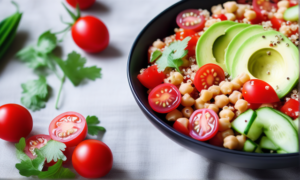 Heart-Healthy Chickpea & Quinoa Grain Bowl
Grain bowls come in countless variations, each offering a unique twist. However, we lean towards a classic and straightforward approach, featuring heart-healthy ingredients like hummus, quinoa, avocado, and a medley of vibrant veggies!
Ingredients:
1 cup cooked quinoa
⅓ cup canned chickpeas, rinsed and drained
½ cup cucumber slices
½ cup cherry tomatoes, halved
¼ avocado, diced
3 tablespoons hummus
1 tablespoon finely chopped roasted red pepper
1 tablespoon lemon juice
1 tablespoon water (plus more if desired)
1 teaspoon chopped fresh parsley (Optional)
Pinch of salt
Pinch of ground pepper
Directions:
Arrange quinoa, chickpeas, cucumbers, tomatoes, and avocado in a wide bowl.
In a separate bowl, stir hummus, roasted red pepper, lemon juice, and water. Adjust water to achieve the desired consistency for the dressing. Add parsley, salt, and pepper, and stir to combine.
Serve the heart-healthy Buddha bowl, promoting overall well-being with every delicious bite.
Heart-Healthy Chickpea & Quinoa Grain Bowl
Grain bowls come in countless variations, each offering a unique twist. However, we lean towards a classic and straightforward approach, featuring heart-healthy ingredients like hummus, quinoa, avocado, and a medley of vibrant veggies!
Ingredients:
1 cup cooked quinoa
⅓ cup canned chickpeas, rinsed and drained
½ cup cucumber slices
½ cup cherry tomatoes, halved
¼ avocado, diced
3 tablespoons hummus
1 tablespoon finely chopped roasted red pepper
1 tablespoon lemon juice
1 tablespoon water (plus more if desired)
1 teaspoon chopped fresh parsley (Optional)
Pinch of salt
Pinch of ground pepper
Directions:
Arrange quinoa, chickpeas, cucumbers, tomatoes, and avocado in a wide bowl.
In a separate bowl, stir hummus, roasted red pepper, lemon juice, and water. Adjust water to achieve the desired consistency for the dressing. Add parsley, salt, and pepper, and stir to combine.
Serve the heart-healthy Buddha bowl, promoting overall well-being with every delicious bite.
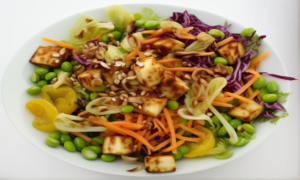 Low-Calorie Crunchy Cabbage, Tofu & Edamame Salad
Satisfy your craving for crunch with this low-calorie salad featuring crisp red cabbage, edamame, bamboo shoots, and chow mein noodles. The delightful sweetness comes from baked tofu, mandarin oranges, and a drizzle of sesame vinaigrette.
Ingredients:
4 cups mesclun
½ cup shredded red cabbage
3 ounces baked tofu cubes
½ cup grated carrots
½ cup edamame
¼ cup mandarin oranges
1 tablespoon golden raisins
½ cup bamboo shoots
2 tablespoons chow mein noodles
2 tablespoons bottled reduced-sugar Asian sesame vinaigrette
Directions:In a medium bowl, mix mesclun, cabbage, tofu, carrots, edamame, oranges, raisins, bamboo shoots, and chow mein noodles. Drizzle with reduced-sugar Asian sesame vinaigrette for a flavorful, low-calorie experience.
Low-Calorie Crunchy Cabbage, Tofu & Edamame Salad
Satisfy your craving for crunch with this low-calorie salad featuring crisp red cabbage, edamame, bamboo shoots, and chow mein noodles. The delightful sweetness comes from baked tofu, mandarin oranges, and a drizzle of sesame vinaigrette.
Ingredients:
4 cups mesclun
½ cup shredded red cabbage
3 ounces baked tofu cubes
½ cup grated carrots
½ cup edamame
¼ cup mandarin oranges
1 tablespoon golden raisins
½ cup bamboo shoots
2 tablespoons chow mein noodles
2 tablespoons bottled reduced-sugar Asian sesame vinaigrette
Directions:In a medium bowl, mix mesclun, cabbage, tofu, carrots, edamame, oranges, raisins, bamboo shoots, and chow mein noodles. Drizzle with reduced-sugar Asian sesame vinaigrette for a flavorful, low-calorie experience.
Classics Games
Hot Recipes
Latest Lists
 Low-Calorie Mango-Almond Smoothie Bowl
Indulge in a delicious and nutritious treat with our Mango-Almond Smoothie Bowl. Packed with flavor and goodness, this recipe ensures a satisfying experience while keeping the calorie count in check. Enjoy the thick, creamy, and frosty texture without any guilt.
Ingredients:
½ cup frozen chopped mango
½ cup nonfat plain Greek yogurt
¼ cup frozen sliced banana
¼ cup plain unsweetened almond milk
5 tablespoons unsalted almonds, divided
⅛ teaspoon ground allspice
¼ cup raspberries
½ teaspoon honey
Directions:
Blend mango, yogurt, banana, almond milk, 3 tablespoons almonds, and allspice in a blender until very smooth.
Pour the smoothie into a bowl and top with raspberries, the remaining 2 tablespoons almonds, and honey.
Low-Calorie Note:Delight in the luscious Mango-Almond Smoothie Bowl without compromising your calorie goals. This recipe offers a guilt-free option for a wholesome and flavorful breakfast or snack.
Low-Calorie Mango-Almond Smoothie Bowl
Indulge in a delicious and nutritious treat with our Mango-Almond Smoothie Bowl. Packed with flavor and goodness, this recipe ensures a satisfying experience while keeping the calorie count in check. Enjoy the thick, creamy, and frosty texture without any guilt.
Ingredients:
½ cup frozen chopped mango
½ cup nonfat plain Greek yogurt
¼ cup frozen sliced banana
¼ cup plain unsweetened almond milk
5 tablespoons unsalted almonds, divided
⅛ teaspoon ground allspice
¼ cup raspberries
½ teaspoon honey
Directions:
Blend mango, yogurt, banana, almond milk, 3 tablespoons almonds, and allspice in a blender until very smooth.
Pour the smoothie into a bowl and top with raspberries, the remaining 2 tablespoons almonds, and honey.
Low-Calorie Note:Delight in the luscious Mango-Almond Smoothie Bowl without compromising your calorie goals. This recipe offers a guilt-free option for a wholesome and flavorful breakfast or snack.
 Low-Calorie Huevos Rancheros Tacos
Enjoy the fusion of Tex-Mex flavors in a guilt-free manner with our Huevos Rancheros Tacos. Whether it's breakfast, brunch, lunch, or dinner, these Tacos Rancheros bring together the classic taste of tacos and the goodness of eggs. Indulge in this savory delight without the worry of excess calories.
Ingredients:
2 teaspoons olive oil
½ cup chopped red onion (1 medium)
2 cloves garlic, minced
1 (15-ounce) can no-salt-added pinto beans, drained
½ teaspoon ground cumin
¼ teaspoon kosher salt
¼ teaspoon dried oregano, crushed
⅛ teaspoon cayenne pepper
½ cup water
Nonstick cooking spray
3 eggs
9 egg whites
8 6-inch corn tortillas, warmed
½ cup shredded reduced-fat Colby and Monterey Jack cheese (2 ounces)
½ cup refrigerated pico de gallo
Directions:
In a 10-inch nonstick skillet, heat oil over medium. Add onion; cook about 4 minutes or until softened. Add garlic; cook for an additional 30 seconds. Remove from heat.
Stir beans, cumin, salt, oregano, and cayenne pepper into the onion mixture; mash with the back of a spoon. Return to heat, add water, and continue mashing. Simmer until beans reach a thick, spreadable consistency. Remove from skillet; keep warm.
Rinse and dry the skillet; coat with cooking spray. Heat the skillet over medium.
In a large bowl, whisk together eggs and egg whites. Add the egg mixture to the skillet and cook without stirring until eggs begin to set on the bottom and around edges. Lift and fold the partially cooked egg mixture with a spatula, allowing the uncooked portion to flow underneath. Continue cooking 2 to 3 minutes or until cooked through but still glossy and moist.
To serve, spread bean mixture on warmed tortillas; top with cooked eggs. Sprinkle with cheese, fold in half, and garnish with pico de gallo.
Low-Calorie Note: Revel in the vibrant flavors of these Huevos Rancheros Tacos without the calorie concerns. A wholesome and satisfying option for those mindful of their calorie intake.
Low-Calorie Huevos Rancheros Tacos
Enjoy the fusion of Tex-Mex flavors in a guilt-free manner with our Huevos Rancheros Tacos. Whether it's breakfast, brunch, lunch, or dinner, these Tacos Rancheros bring together the classic taste of tacos and the goodness of eggs. Indulge in this savory delight without the worry of excess calories.
Ingredients:
2 teaspoons olive oil
½ cup chopped red onion (1 medium)
2 cloves garlic, minced
1 (15-ounce) can no-salt-added pinto beans, drained
½ teaspoon ground cumin
¼ teaspoon kosher salt
¼ teaspoon dried oregano, crushed
⅛ teaspoon cayenne pepper
½ cup water
Nonstick cooking spray
3 eggs
9 egg whites
8 6-inch corn tortillas, warmed
½ cup shredded reduced-fat Colby and Monterey Jack cheese (2 ounces)
½ cup refrigerated pico de gallo
Directions:
In a 10-inch nonstick skillet, heat oil over medium. Add onion; cook about 4 minutes or until softened. Add garlic; cook for an additional 30 seconds. Remove from heat.
Stir beans, cumin, salt, oregano, and cayenne pepper into the onion mixture; mash with the back of a spoon. Return to heat, add water, and continue mashing. Simmer until beans reach a thick, spreadable consistency. Remove from skillet; keep warm.
Rinse and dry the skillet; coat with cooking spray. Heat the skillet over medium.
In a large bowl, whisk together eggs and egg whites. Add the egg mixture to the skillet and cook without stirring until eggs begin to set on the bottom and around edges. Lift and fold the partially cooked egg mixture with a spatula, allowing the uncooked portion to flow underneath. Continue cooking 2 to 3 minutes or until cooked through but still glossy and moist.
To serve, spread bean mixture on warmed tortillas; top with cooked eggs. Sprinkle with cheese, fold in half, and garnish with pico de gallo.
Low-Calorie Note: Revel in the vibrant flavors of these Huevos Rancheros Tacos without the calorie concerns. A wholesome and satisfying option for those mindful of their calorie intake.
 Low-Calorie Strawberry-Banana Protein Smoothie
Indulge in a delicious and low-calorie treat with our Strawberry-Banana Protein Smoothie. Packed with protein from Greek yogurt and nut butter, along with the added benefits of omega-3s from ground flaxseed, this smoothie is a nutritious delight. Whether you prefer a frosty texture with ice cubes or a milder temperature with water, this recipe offers flexibility to suit your taste.
Ingredients:
1 cup hulled strawberries, fresh or frozen
½ medium banana
½ cup diced mango, fresh or frozen
½ cup nonfat plain Greek yogurt
1 tablespoon natural nut butter, such as cashew or almond
1 tablespoon ground flaxseed (flaxmeal)
¼ teaspoon vanilla extract
4 ice cubes or ½ cup water
Directions:
Combine strawberries, banana, mango, yogurt, nut butter, flaxmeal, vanilla, and ice cubes (or water) in a blender.
Puree until smooth.
Low-Calorie Note: Savor the rich flavors of this Strawberry-Banana Protein Smoothie without worrying about excess calories. Packed with wholesome ingredients, it's a guilt-free option for a satisfying and nutritious beverage.
Low-Calorie Strawberry-Banana Protein Smoothie
Indulge in a delicious and low-calorie treat with our Strawberry-Banana Protein Smoothie. Packed with protein from Greek yogurt and nut butter, along with the added benefits of omega-3s from ground flaxseed, this smoothie is a nutritious delight. Whether you prefer a frosty texture with ice cubes or a milder temperature with water, this recipe offers flexibility to suit your taste.
Ingredients:
1 cup hulled strawberries, fresh or frozen
½ medium banana
½ cup diced mango, fresh or frozen
½ cup nonfat plain Greek yogurt
1 tablespoon natural nut butter, such as cashew or almond
1 tablespoon ground flaxseed (flaxmeal)
¼ teaspoon vanilla extract
4 ice cubes or ½ cup water
Directions:
Combine strawberries, banana, mango, yogurt, nut butter, flaxmeal, vanilla, and ice cubes (or water) in a blender.
Puree until smooth.
Low-Calorie Note: Savor the rich flavors of this Strawberry-Banana Protein Smoothie without worrying about excess calories. Packed with wholesome ingredients, it's a guilt-free option for a satisfying and nutritious beverage.
 Low-Calorie Spinach & Egg Tacos
Enjoy a light and nutritious breakfast with these low-calorie Spinach & Egg Tacos. Hard-boiled eggs, spinach, cheese, and salsa come together in a flavorful combination. Mashed avocado adds creaminess, while a splash of lime juice brings a refreshing acidity. This quick and easy recipe is perfect for a satisfying start to your day.
Ingredients:
¼ avocado
1 teaspoon lime juice
2 hard-boiled eggs, chopped
2 corn tortillas, warmed
1 cup chopped spinach, divided
2 tablespoons shredded Cheddar cheese, divided
2 tablespoons salsa, divided
Directions:
In a small bowl, mash avocado with lime juice and salt.
Mix in chopped eggs.
Divide the avocado and egg mixture between warmed tortillas.
Top each taco with 1/2 cup spinach and 1 tablespoon each of shredded Cheddar cheese and salsa.
Low-Calorie Note: Delight in the flavors of these Spinach & Egg Tacos without compromising on your calorie goals. Packed with protein and veggies, it's a wholesome and satisfying breakfast option.
Low-Calorie Spinach & Egg Tacos
Enjoy a light and nutritious breakfast with these low-calorie Spinach & Egg Tacos. Hard-boiled eggs, spinach, cheese, and salsa come together in a flavorful combination. Mashed avocado adds creaminess, while a splash of lime juice brings a refreshing acidity. This quick and easy recipe is perfect for a satisfying start to your day.
Ingredients:
¼ avocado
1 teaspoon lime juice
2 hard-boiled eggs, chopped
2 corn tortillas, warmed
1 cup chopped spinach, divided
2 tablespoons shredded Cheddar cheese, divided
2 tablespoons salsa, divided
Directions:
In a small bowl, mash avocado with lime juice and salt.
Mix in chopped eggs.
Divide the avocado and egg mixture between warmed tortillas.
Top each taco with 1/2 cup spinach and 1 tablespoon each of shredded Cheddar cheese and salsa.
Low-Calorie Note: Delight in the flavors of these Spinach & Egg Tacos without compromising on your calorie goals. Packed with protein and veggies, it's a wholesome and satisfying breakfast option.
 Low-Calorie Savory Oatmeal with Cheddar, Collards & Eggs
Indulge in the savory side of oats with this delicious and low-calorie recipe. Experience a delightful twist to the usual sweet oatmeal by incorporating a generous serving of vegetables. Savor the combination of Cheddar, collards, and eggs, creating a wholesome meal. Spice it up with hot sauce for an extra kick, if desired.
Ingredients:
2 tablespoons extra-virgin olive oil, divided
2 tablespoons diced shallot
2 cups rolled oats (see Tip)
4 cups water plus 1/2 cup, divided
½ teaspoon salt, divided
½ teaspoon ground pepper, divided
10 cups chopped collard greens (from 1-2 bunches)
2 teaspoons red-wine vinegar
1 cup shredded Cheddar cheese
¼ cup chipotle salsa, plus more for serving
4 large eggs, cooked as desired
Directions:
Heat 1 tablespoon oil in a large saucepan over medium heat. Add shallot and cook until softened, 1 to 2 minutes. Stir in oats and cook for an additional 1 minute. Add 4 cups water, 1/4 teaspoon salt, and 1/4 teaspoon pepper. Bring to a boil, then simmer until creamy, 10 to 12 minutes.
In a large skillet, heat the remaining 1 tablespoon oil over medium-high heat. Add collards, 1/2 cup water, 1/4 teaspoon salt, and 1/4 teaspoon pepper. Cook until tender, 5 to 7 minutes. Remove from heat and stir in vinegar.
Stir cheese and salsa into the oatmeal. Serve with collards, eggs, and additional salsa, if desired.
Low-Calorie Note: Relish the savory goodness of this oatmeal while keeping your calorie intake in check. Packed with vegetables, Cheddar, and eggs, it's a balanced and flavorful option for a satisfying meal.
Low-Calorie Savory Oatmeal with Cheddar, Collards & Eggs
Indulge in the savory side of oats with this delicious and low-calorie recipe. Experience a delightful twist to the usual sweet oatmeal by incorporating a generous serving of vegetables. Savor the combination of Cheddar, collards, and eggs, creating a wholesome meal. Spice it up with hot sauce for an extra kick, if desired.
Ingredients:
2 tablespoons extra-virgin olive oil, divided
2 tablespoons diced shallot
2 cups rolled oats (see Tip)
4 cups water plus 1/2 cup, divided
½ teaspoon salt, divided
½ teaspoon ground pepper, divided
10 cups chopped collard greens (from 1-2 bunches)
2 teaspoons red-wine vinegar
1 cup shredded Cheddar cheese
¼ cup chipotle salsa, plus more for serving
4 large eggs, cooked as desired
Directions:
Heat 1 tablespoon oil in a large saucepan over medium heat. Add shallot and cook until softened, 1 to 2 minutes. Stir in oats and cook for an additional 1 minute. Add 4 cups water, 1/4 teaspoon salt, and 1/4 teaspoon pepper. Bring to a boil, then simmer until creamy, 10 to 12 minutes.
In a large skillet, heat the remaining 1 tablespoon oil over medium-high heat. Add collards, 1/2 cup water, 1/4 teaspoon salt, and 1/4 teaspoon pepper. Cook until tender, 5 to 7 minutes. Remove from heat and stir in vinegar.
Stir cheese and salsa into the oatmeal. Serve with collards, eggs, and additional salsa, if desired.
Low-Calorie Note: Relish the savory goodness of this oatmeal while keeping your calorie intake in check. Packed with vegetables, Cheddar, and eggs, it's a balanced and flavorful option for a satisfying meal.
 Low-Calorie Strawberry-Banana Green Smoothie Recipe
Enjoy a burst of freshness with this low-calorie strawberry-banana green smoothie. Sweetened only with fruit, this delightful smoothie packs a nutritious punch with the added goodness of omega-3s from flaxseeds. Sip on this green goodness for a guilt-free and refreshing treat.
Ingredients:
1 medium banana
1 cup baby spinach
½ cup low-fat plain Greek yogurt
½ cup nonfat milk
6 frozen strawberries
1 tablespoon flaxseeds
Directions:
Puree banana, spinach, yogurt, milk, strawberries, and flaxseeds in a blender until smooth.
Low-Calorie Note: Indulge in the vibrant flavors of this strawberry-banana green smoothie without worrying about excess calories. With a perfect blend of spinach, yogurt, and the natural sweetness of fruits, it's a nutrient-packed, low-calorie option for a healthy start to your day.
Low-Calorie Strawberry-Banana Green Smoothie Recipe
Enjoy a burst of freshness with this low-calorie strawberry-banana green smoothie. Sweetened only with fruit, this delightful smoothie packs a nutritious punch with the added goodness of omega-3s from flaxseeds. Sip on this green goodness for a guilt-free and refreshing treat.
Ingredients:
1 medium banana
1 cup baby spinach
½ cup low-fat plain Greek yogurt
½ cup nonfat milk
6 frozen strawberries
1 tablespoon flaxseeds
Directions:
Puree banana, spinach, yogurt, milk, strawberries, and flaxseeds in a blender until smooth.
Low-Calorie Note: Indulge in the vibrant flavors of this strawberry-banana green smoothie without worrying about excess calories. With a perfect blend of spinach, yogurt, and the natural sweetness of fruits, it's a nutrient-packed, low-calorie option for a healthy start to your day.
 Low-Calorie Peanut Butter & Jelly Smoothie Recipe
Indulge in the classic PB & J flavors without the guilt with this low-calorie peanut butter and jelly smoothie. Packed with nutritious ingredients like Greek yogurt, spinach, and strawberries, this protein-rich smoothie is a healthy and delicious alternative to the traditional sandwich. Skip the bread and savor the goodness in every sip of this satisfying smoothie.
Ingredients:
½ cup low-fat milk
⅓ cup nonfat plain Greek yogurt
1 cup baby spinach
1 cup frozen banana slices (about 1 medium banana)
½ cup frozen strawberries
1 tablespoon natural peanut butter
1-2 teaspoons pure maple syrup or honey (optional)
Directions:
Add milk and yogurt to a blender, then add spinach, banana, strawberries, peanut butter, and sweetener (if using); blend until smooth.
Low-Calorie Note: This peanut butter and jelly smoothie is not just a tasty treat but also a low-calorie delight. With the richness of peanut butter, the freshness of spinach, and the sweetness of strawberries, it's a wholesome, protein-packed smoothie without the excess calories. Enjoy the classic combination in a healthier form.
Low-Calorie Peanut Butter & Jelly Smoothie Recipe
Indulge in the classic PB & J flavors without the guilt with this low-calorie peanut butter and jelly smoothie. Packed with nutritious ingredients like Greek yogurt, spinach, and strawberries, this protein-rich smoothie is a healthy and delicious alternative to the traditional sandwich. Skip the bread and savor the goodness in every sip of this satisfying smoothie.
Ingredients:
½ cup low-fat milk
⅓ cup nonfat plain Greek yogurt
1 cup baby spinach
1 cup frozen banana slices (about 1 medium banana)
½ cup frozen strawberries
1 tablespoon natural peanut butter
1-2 teaspoons pure maple syrup or honey (optional)
Directions:
Add milk and yogurt to a blender, then add spinach, banana, strawberries, peanut butter, and sweetener (if using); blend until smooth.
Low-Calorie Note: This peanut butter and jelly smoothie is not just a tasty treat but also a low-calorie delight. With the richness of peanut butter, the freshness of spinach, and the sweetness of strawberries, it's a wholesome, protein-packed smoothie without the excess calories. Enjoy the classic combination in a healthier form.
 Low-Calorie Strawberry & Yogurt Parfait Recipe
Indulge in a guilt-free breakfast with this delightful low-calorie strawberry parfait. Combining fresh fruit, creamy Greek yogurt, and crunchy granola, this easy-to-make parfait is not only delicious but also a healthy choice. Perfect for a breakfast on the go, pack this delightful treat in a Mason jar and savor the goodness of a nutritious start to your day.
Ingredients:
1 cup sliced fresh strawberries
1 teaspoon sugar
½ cup nonfat plain Greek yogurt
¼ cup granola
Directions:
Combine strawberries and sugar in a small bowl and let stand until the berries start to release juice, about 5 minutes.
To assemble the parfait, layer yogurt and the strawberries with their juice in a 2-cup container.
Top with granola.
Low-Calorie Note: This strawberry and yogurt parfait is not only delicious but also a low-calorie breakfast option. Packed with the goodness of fresh strawberries, protein-rich Greek yogurt, and a touch of granola for crunch, it's a satisfying choice without the extra calories. Enjoy the sweetness of strawberries and the creaminess of yogurt guilt-free.
Low-Calorie Strawberry & Yogurt Parfait Recipe
Indulge in a guilt-free breakfast with this delightful low-calorie strawberry parfait. Combining fresh fruit, creamy Greek yogurt, and crunchy granola, this easy-to-make parfait is not only delicious but also a healthy choice. Perfect for a breakfast on the go, pack this delightful treat in a Mason jar and savor the goodness of a nutritious start to your day.
Ingredients:
1 cup sliced fresh strawberries
1 teaspoon sugar
½ cup nonfat plain Greek yogurt
¼ cup granola
Directions:
Combine strawberries and sugar in a small bowl and let stand until the berries start to release juice, about 5 minutes.
To assemble the parfait, layer yogurt and the strawberries with their juice in a 2-cup container.
Top with granola.
Low-Calorie Note: This strawberry and yogurt parfait is not only delicious but also a low-calorie breakfast option. Packed with the goodness of fresh strawberries, protein-rich Greek yogurt, and a touch of granola for crunch, it's a satisfying choice without the extra calories. Enjoy the sweetness of strawberries and the creaminess of yogurt guilt-free.
 Low-Calorie Cauliflower English Muffins Recipe
Indulge in a guilt-free breakfast with these savory and gluten-free cauliflower English muffins. Using cauliflower instead of flour, these muffins are bound together with a hint of cheese and egg, making them a delicious grain-free alternative. Top them with sweet jam or assemble a tasty breakfast sandwich for a wholesome start to your day.
Ingredients:
5 cups cauliflower florets (about 1 pound)
1 cup shredded sharp Cheddar cheese
1 large egg, lightly beaten
⅛ teaspoon salt
Directions:
Preheat oven to 425 degrees F. Line a large baking sheet with parchment paper.
Place cauliflower in a food processor and process until finely grated.
Transfer the cauliflower to a microwave-safe bowl, cover loosely, and microwave on High for 3 minutes. Let it cool slightly.
Transfer the cauliflower to a clean kitchen towel, wring out excess moisture, and return it to the bowl.
Stir in Cheddar, egg, and salt until thoroughly combined.
Place a 3-inch biscuit cutter on the prepared baking sheet. Fill the cutter with about 1/4 cup of the batter, patting down slightly in the mold.
Repeat with the remaining batter, leaving about 1 inch between each one, until you have 8 "muffins."
Bake until browned and crispy around the edges, about 25 minutes.
Serve with your favorite toppings or use them to make a delightful breakfast sandwich.
Low-Calorie Note: These cauliflower English muffins are a waistline-friendly choice, offering a satisfying breakfast option with fewer calories. Enjoy a delicious and nutritious start to your day without compromising on flavor.
Low-Calorie Cauliflower English Muffins Recipe
Indulge in a guilt-free breakfast with these savory and gluten-free cauliflower English muffins. Using cauliflower instead of flour, these muffins are bound together with a hint of cheese and egg, making them a delicious grain-free alternative. Top them with sweet jam or assemble a tasty breakfast sandwich for a wholesome start to your day.
Ingredients:
5 cups cauliflower florets (about 1 pound)
1 cup shredded sharp Cheddar cheese
1 large egg, lightly beaten
⅛ teaspoon salt
Directions:
Preheat oven to 425 degrees F. Line a large baking sheet with parchment paper.
Place cauliflower in a food processor and process until finely grated.
Transfer the cauliflower to a microwave-safe bowl, cover loosely, and microwave on High for 3 minutes. Let it cool slightly.
Transfer the cauliflower to a clean kitchen towel, wring out excess moisture, and return it to the bowl.
Stir in Cheddar, egg, and salt until thoroughly combined.
Place a 3-inch biscuit cutter on the prepared baking sheet. Fill the cutter with about 1/4 cup of the batter, patting down slightly in the mold.
Repeat with the remaining batter, leaving about 1 inch between each one, until you have 8 "muffins."
Bake until browned and crispy around the edges, about 25 minutes.
Serve with your favorite toppings or use them to make a delightful breakfast sandwich.
Low-Calorie Note: These cauliflower English muffins are a waistline-friendly choice, offering a satisfying breakfast option with fewer calories. Enjoy a delicious and nutritious start to your day without compromising on flavor.
 Low-Calorie Shakshuka (Eggs Poached in Spicy Tomato Sauce)
Indulge in a flavorful and low-calorie version of Shakshuka, a veggie-packed delight featuring poached eggs in a spicy blend of tomatoes, onions, peppers, and aromatic spices. Originating from North Africa and the Middle East, this dish is perfect for a satisfying breakfast or lunch.
Ingredients:
2 tablespoons olive oil
2 cups chopped red sweet peppers
½ cup chopped onion
2 tablespoons no-salt-added tomato paste
1 teaspoon smoked paprika
2 teaspoons crushed red pepper
3 cups chopped tomatoes
1 teaspoon ground cumin
¼ teaspoon salt
4 eggs
½ cup plain low-fat Greek yogurt
Snipped fresh parsley
2 whole-wheat pita bread rounds, halved crosswise and warmed
Directions:
In a 10-inch skillet, heat olive oil over medium heat. Add the next five ingredients (through crushed red pepper). Cook for 5 to 7 minutes or until the onion is tender, stirring occasionally.
Stir in tomatoes, cumin, and salt. Bring to a boil; then reduce heat. Simmer for 10 minutes or until the tomatoes begin to break down.
Make four indentations in the tomato mixture. Break an egg into a custard cup or small bowl and slip it into an indentation. Repeat with the remaining three eggs. Simmer, covered, for 4 to 6 minutes or until the whites are completely set, and yolks begin to thicken but are not hard.
Top with yogurt and sprinkle with parsley. Serve with warm, halved whole-wheat pita bread rounds.
Low-Calorie Note:This Shakshuka recipe offers a deliciously satisfying experience with lower calorie content, making it an ideal choice for those looking to enjoy a flavorful meal while being mindful of their calorie intake.
Low-Calorie Shakshuka (Eggs Poached in Spicy Tomato Sauce)
Indulge in a flavorful and low-calorie version of Shakshuka, a veggie-packed delight featuring poached eggs in a spicy blend of tomatoes, onions, peppers, and aromatic spices. Originating from North Africa and the Middle East, this dish is perfect for a satisfying breakfast or lunch.
Ingredients:
2 tablespoons olive oil
2 cups chopped red sweet peppers
½ cup chopped onion
2 tablespoons no-salt-added tomato paste
1 teaspoon smoked paprika
2 teaspoons crushed red pepper
3 cups chopped tomatoes
1 teaspoon ground cumin
¼ teaspoon salt
4 eggs
½ cup plain low-fat Greek yogurt
Snipped fresh parsley
2 whole-wheat pita bread rounds, halved crosswise and warmed
Directions:
In a 10-inch skillet, heat olive oil over medium heat. Add the next five ingredients (through crushed red pepper). Cook for 5 to 7 minutes or until the onion is tender, stirring occasionally.
Stir in tomatoes, cumin, and salt. Bring to a boil; then reduce heat. Simmer for 10 minutes or until the tomatoes begin to break down.
Make four indentations in the tomato mixture. Break an egg into a custard cup or small bowl and slip it into an indentation. Repeat with the remaining three eggs. Simmer, covered, for 4 to 6 minutes or until the whites are completely set, and yolks begin to thicken but are not hard.
Top with yogurt and sprinkle with parsley. Serve with warm, halved whole-wheat pita bread rounds.
Low-Calorie Note:This Shakshuka recipe offers a deliciously satisfying experience with lower calorie content, making it an ideal choice for those looking to enjoy a flavorful meal while being mindful of their calorie intake.
 Raspberry-Peach-Mango Smoothie Bowl Recipe
Embark on a delicious journey with this Raspberry-Peach-Mango Smoothie Bowl, a nutritious and customizable delight that introduces you to the craze of smoothie bowls. Feel free to personalize it with your favorite fruits, nuts, and seeds to make it uniquely yours. Using frozen fruit in Step 1 ensures a lusciously creamy and frosty base for the delightful toppings.
Ingredients:
1 cup frozen mango chunks
¾ cup nonfat plain Greek yogurt
¼ cup reduced-fat milk
1 teaspoon vanilla extract
¼ ripe peach, sliced
⅓ cup raspberries
1 tablespoon sliced almonds, toasted if desired
1 tablespoon unsweetened coconut flakes, toasted if desired
1 teaspoon chia seeds
Directions:
Combine frozen mango, yogurt, milk, and vanilla in a blender. Puree until smooth.
Pour the smoothie into a bowl and artfully top it with sliced peach, raspberries, almonds, toasted coconut, and chia seeds according to your taste preferences.
Raspberry-Peach-Mango Smoothie Bowl Recipe
Embark on a delicious journey with this Raspberry-Peach-Mango Smoothie Bowl, a nutritious and customizable delight that introduces you to the craze of smoothie bowls. Feel free to personalize it with your favorite fruits, nuts, and seeds to make it uniquely yours. Using frozen fruit in Step 1 ensures a lusciously creamy and frosty base for the delightful toppings.
Ingredients:
1 cup frozen mango chunks
¾ cup nonfat plain Greek yogurt
¼ cup reduced-fat milk
1 teaspoon vanilla extract
¼ ripe peach, sliced
⅓ cup raspberries
1 tablespoon sliced almonds, toasted if desired
1 tablespoon unsweetened coconut flakes, toasted if desired
1 teaspoon chia seeds
Directions:
Combine frozen mango, yogurt, milk, and vanilla in a blender. Puree until smooth.
Pour the smoothie into a bowl and artfully top it with sliced peach, raspberries, almonds, toasted coconut, and chia seeds according to your taste preferences.
 Debunking the Myth: Does High-Fiber Food Lead to Weight Gain? Insights from Nutritionists
Introduction:
There's a common misconception that consuming high-fiber foods can lead to weight gain, but the reality is quite the opposite. While fiber may not be the most glamorous nutrient, its significance in maintaining overall health cannot be overstated. Abundant in plant-based foods, dietary fiber is an indigestible carbohydrate that aids in maintaining a healthy digestive system, transporting LDL cholesterol away from the heart, promoting satiety, and regulating blood sugar levels. According to the Centers for Disease Control and Prevention (CDC), a fiber-rich diet is linked to reduced risks of heart disease, diabetes, and certain types of cancers.
For optimal health, it's encouraged to increase the intake of fiber-rich foods such as fruits, vegetables, nuts, seeds, legumes, and whole grains. However, does consuming fiber contribute to weight loss, or can overconsumption lead to weight gain?
This article will explore how fiber facilitates weight loss, why some may perceive it as a weight-gaining factor, the role of fiber supplements, and 10 simple ways to increase fiber intake.
Why Fiber Promotes Healthy Weight Loss:
Despite the numerous health benefits of fiber, the majority of Americans, as per the 2020-2025 Dietary Guidelines, fall short of the recommended daily fiber intake (25 to 34 grams). In addition to promoting heart health and a well-functioning digestive system, fiber has been proven to support healthy weight loss through various potential mechanisms.
Increased Satiety:Fiber induces a sense of fullness, requiring longer chewing time, stimulating saliva and gastric acid production, and slowing down stomach emptying. Prolonged satiety may lead to reduced overall calorie intake, creating a calorie deficit and resulting in weight loss. Research suggests that the impact of fiber on satiety depends on factors such as fiber quantity, molecular size, solubility, and the food matrix.
Supports Diet Adherence:In a 2019 study published in the Nutrition Journal, researchers found that dietary fiber intake, unrelated to nutrient and calorie intake, facilitated weight loss and adherence to diet restrictions in adults struggling with overweight or obesity.
Improves Gut Microbiota:Certain types of dietary fiber, known as prebiotics, can increase the presence of beneficial bacteria like bifidobacteria and lactobacilli in the gut. Diverse and healthy gut microbiota is associated with weight loss and reduced obesity risk, as highlighted in a 2017 review in Translational Medicine and a 2018 review in Genes.
Blood Sugar Regulation:Fiber plays a crucial role in slowing down the metabolism of glucose from carbohydrates, leading to a gradual and steady postprandial blood sugar response. This stable response is linked to increased satiety.
Why You Might Think Fiber Causes Weight Gain:
A sudden or significant increase in fiber intake, especially without sufficient water consumption, can lead to bloating, abdominal distension, and constipation. When your stomach feels bloated or your bowel movements are irregular, you might perceive a temporary weight gain due to fecal support affecting scale readings. However, sustained weight gain requires consuming more calories than your body needs.
Are Fiber Supplements Beneficial for Weight Loss?
While fiber supplements may contribute to increased fiber intake, they do not address other behavioral factors influencing weight, such as stress, sleep, physical activity, and dietary choices. Fiber supplements lack the diverse nutritional components present in whole foods, emphasizing the importance of a food-first approach for weight management. Additionally, the effectiveness of fiber supplements may vary among individuals.
10 Simple Ways to Increase Fiber Intake:
As per the Dietary Guidelines, adult women are recommended to consume 25 to 28 grams of fiber daily, while adult men should aim for 31 to 34 grams. For those not accustomed to consuming fiber-rich foods, gradually increasing intake while ensuring adequate water intake can minimize bloating and prevent constipation, nausea, and dehydration. Here are 10 practical ways to boost daily fiber consumption:
Start your day with a fiber-rich breakfast, such as vegetable omelets with whole-grain bread, low-fat yogurt with fruits and nuts, a fruit or vegetable high-protein smoothie, or fiber-rich overnight oats.
Add one serving of fruit or vegetables to each meal, aiming for 1.5 to 2 cups of fruit and 2 to 3 cups of vegetables daily for adults.
Consume fruit and vegetable skins, such as apples, pears, and potatoes.
Include one serving of berries in your daily diet; one cup of raspberries, for example, contains 8 grams of fiber.
Eat one serving (1 to 1.5 ounces) of nuts daily, which provide fiber and omega-3 fatty acids crucial for heart, eye, brain, and skin health.
Practice the USDA's MyPlate method, filling half your plate with non-starchy vegetables, one-quarter with protein sources (fish, chicken, turkey, lean beef, tofu), and the remaining quarter with starchy protein sources (whole grains or starchy vegetables like sweet potatoes, potatoes, pumpkin, or butternut squash).
Add a tablespoon of fiber-rich seeds to snacks, such as chia seeds, flaxseed powder, hemp seeds, or pumpkin seeds, in yogurt, cheese, oats, or non-dairy yogurt alternatives.
Choose whole grains for half of your grains, including whole-grain bread, whole wheat, oats, popcorn, corn, farro, freekeh, quinoa, barley, brown rice, wild rice, and teff.
Include half a cup of legumes in your daily routine; for example, mix chopped vegetables with hummus or chickpea puree. Half a cup of beans contains at least 5 grams of fiber.
Consume avocados in various forms, such as in top-tier sandwiches, vegetable bowls, wraps, or whole-grain crackers. According to USDA data, half a medium-sized avocado contains around 6 grams of fiber.
In conclusion, rather than causing weight gain, a well-rounded diet rich in fiber can significantly contribute to healthy weight loss and overall well-being. The key is to adopt a balanced and sustainable approach to dietary choices, embracing a variety of nutrient-dense foods.
Debunking the Myth: Does High-Fiber Food Lead to Weight Gain? Insights from Nutritionists
Introduction:
There's a common misconception that consuming high-fiber foods can lead to weight gain, but the reality is quite the opposite. While fiber may not be the most glamorous nutrient, its significance in maintaining overall health cannot be overstated. Abundant in plant-based foods, dietary fiber is an indigestible carbohydrate that aids in maintaining a healthy digestive system, transporting LDL cholesterol away from the heart, promoting satiety, and regulating blood sugar levels. According to the Centers for Disease Control and Prevention (CDC), a fiber-rich diet is linked to reduced risks of heart disease, diabetes, and certain types of cancers.
For optimal health, it's encouraged to increase the intake of fiber-rich foods such as fruits, vegetables, nuts, seeds, legumes, and whole grains. However, does consuming fiber contribute to weight loss, or can overconsumption lead to weight gain?
This article will explore how fiber facilitates weight loss, why some may perceive it as a weight-gaining factor, the role of fiber supplements, and 10 simple ways to increase fiber intake.
Why Fiber Promotes Healthy Weight Loss:
Despite the numerous health benefits of fiber, the majority of Americans, as per the 2020-2025 Dietary Guidelines, fall short of the recommended daily fiber intake (25 to 34 grams). In addition to promoting heart health and a well-functioning digestive system, fiber has been proven to support healthy weight loss through various potential mechanisms.
Increased Satiety:Fiber induces a sense of fullness, requiring longer chewing time, stimulating saliva and gastric acid production, and slowing down stomach emptying. Prolonged satiety may lead to reduced overall calorie intake, creating a calorie deficit and resulting in weight loss. Research suggests that the impact of fiber on satiety depends on factors such as fiber quantity, molecular size, solubility, and the food matrix.
Supports Diet Adherence:In a 2019 study published in the Nutrition Journal, researchers found that dietary fiber intake, unrelated to nutrient and calorie intake, facilitated weight loss and adherence to diet restrictions in adults struggling with overweight or obesity.
Improves Gut Microbiota:Certain types of dietary fiber, known as prebiotics, can increase the presence of beneficial bacteria like bifidobacteria and lactobacilli in the gut. Diverse and healthy gut microbiota is associated with weight loss and reduced obesity risk, as highlighted in a 2017 review in Translational Medicine and a 2018 review in Genes.
Blood Sugar Regulation:Fiber plays a crucial role in slowing down the metabolism of glucose from carbohydrates, leading to a gradual and steady postprandial blood sugar response. This stable response is linked to increased satiety.
Why You Might Think Fiber Causes Weight Gain:
A sudden or significant increase in fiber intake, especially without sufficient water consumption, can lead to bloating, abdominal distension, and constipation. When your stomach feels bloated or your bowel movements are irregular, you might perceive a temporary weight gain due to fecal support affecting scale readings. However, sustained weight gain requires consuming more calories than your body needs.
Are Fiber Supplements Beneficial for Weight Loss?
While fiber supplements may contribute to increased fiber intake, they do not address other behavioral factors influencing weight, such as stress, sleep, physical activity, and dietary choices. Fiber supplements lack the diverse nutritional components present in whole foods, emphasizing the importance of a food-first approach for weight management. Additionally, the effectiveness of fiber supplements may vary among individuals.
10 Simple Ways to Increase Fiber Intake:
As per the Dietary Guidelines, adult women are recommended to consume 25 to 28 grams of fiber daily, while adult men should aim for 31 to 34 grams. For those not accustomed to consuming fiber-rich foods, gradually increasing intake while ensuring adequate water intake can minimize bloating and prevent constipation, nausea, and dehydration. Here are 10 practical ways to boost daily fiber consumption:
Start your day with a fiber-rich breakfast, such as vegetable omelets with whole-grain bread, low-fat yogurt with fruits and nuts, a fruit or vegetable high-protein smoothie, or fiber-rich overnight oats.
Add one serving of fruit or vegetables to each meal, aiming for 1.5 to 2 cups of fruit and 2 to 3 cups of vegetables daily for adults.
Consume fruit and vegetable skins, such as apples, pears, and potatoes.
Include one serving of berries in your daily diet; one cup of raspberries, for example, contains 8 grams of fiber.
Eat one serving (1 to 1.5 ounces) of nuts daily, which provide fiber and omega-3 fatty acids crucial for heart, eye, brain, and skin health.
Practice the USDA's MyPlate method, filling half your plate with non-starchy vegetables, one-quarter with protein sources (fish, chicken, turkey, lean beef, tofu), and the remaining quarter with starchy protein sources (whole grains or starchy vegetables like sweet potatoes, potatoes, pumpkin, or butternut squash).
Add a tablespoon of fiber-rich seeds to snacks, such as chia seeds, flaxseed powder, hemp seeds, or pumpkin seeds, in yogurt, cheese, oats, or non-dairy yogurt alternatives.
Choose whole grains for half of your grains, including whole-grain bread, whole wheat, oats, popcorn, corn, farro, freekeh, quinoa, barley, brown rice, wild rice, and teff.
Include half a cup of legumes in your daily routine; for example, mix chopped vegetables with hummus or chickpea puree. Half a cup of beans contains at least 5 grams of fiber.
Consume avocados in various forms, such as in top-tier sandwiches, vegetable bowls, wraps, or whole-grain crackers. According to USDA data, half a medium-sized avocado contains around 6 grams of fiber.
In conclusion, rather than causing weight gain, a well-rounded diet rich in fiber can significantly contribute to healthy weight loss and overall well-being. The key is to adopt a balanced and sustainable approach to dietary choices, embracing a variety of nutrient-dense foods.
 Breaking 5 Unhealthy Habits to Embark on an Effortless Weight Loss Journey
Introduction:
Obesity is not an overnight occurrence but a result of prolonged calorie surplus over time. To achieve weight loss goals, it is essential to boost metabolism, adjust dietary habits, and engage in adequate exercise to burn calories, allowing your body to gradually regain a healthy and vibrant physique.
1. Prolonged Sedentary Lifestyle and Aging of Body Functions
Sitting for extended periods can have various detrimental effects, such as compression of the spine leading to back issues, fatigue, joint hardening, and hindered lower limb circulation, resulting in undesirable body shapes. Combat these suboptimal health conditions by incorporating activities like squats, push-ups, or leg lifts every hour to promote calorie expenditure and maintain a youthful physique.
2. Late-Night Snacking
Consuming food before bedtime introduces extra calories, contributing to fat accumulation. For effective weight loss, it's recommended to have an early dinner, with a minimum 4-hour gap before sleep, promoting enhanced fat burning during rest.
3. Staying Up Late
Late nights may accelerate aging, hinder metabolism, and disrupt hormone secretion, contributing to weight gain. Adhering to a regular sleep schedule aids in hormone balance, maintaining a youthful physique, and ensuring a well-rested body and mind.
4. High Salt Intake
Foods rich in salt stimulate appetite, leading to increased calorie intake. Maintaining a balanced and low-sodium diet with a focus on vegetables and fruits is crucial for sculpting an ideal body shape.
5. Inactivity After Meals
While dietary control is vital, exercise plays an equally crucial role. Moderate physical activity not only boosts metabolic activity but also enhances overall physical fitness, contributing to a healthier weight loss journey. Starting with a half-hour routine and gradually increasing intensity and duration is an effective approach.
Dietary Tips:
Control food intake to avoid overeating.
Opt for low-fat cooking methods such as steaming, boiling, or baking to reduce fat consumption.
Increase fiber intake with whole grains, vegetables, and fruits to enhance satiety.
Avoid high-sugar, high-fat, and high-salt foods, opting for natural and healthy ingredients.
Conclusion:
By correcting unhealthy habits, adjusting dietary structures, and incorporating moderate exercise, achieving weight loss becomes a manageable journey. Focusing on a well-balanced diet and adopting healthy lifestyle habits not only enhances physical appearance but also provides holistic health improvements.
Breaking 5 Unhealthy Habits to Embark on an Effortless Weight Loss Journey
Introduction:
Obesity is not an overnight occurrence but a result of prolonged calorie surplus over time. To achieve weight loss goals, it is essential to boost metabolism, adjust dietary habits, and engage in adequate exercise to burn calories, allowing your body to gradually regain a healthy and vibrant physique.
1. Prolonged Sedentary Lifestyle and Aging of Body Functions
Sitting for extended periods can have various detrimental effects, such as compression of the spine leading to back issues, fatigue, joint hardening, and hindered lower limb circulation, resulting in undesirable body shapes. Combat these suboptimal health conditions by incorporating activities like squats, push-ups, or leg lifts every hour to promote calorie expenditure and maintain a youthful physique.
2. Late-Night Snacking
Consuming food before bedtime introduces extra calories, contributing to fat accumulation. For effective weight loss, it's recommended to have an early dinner, with a minimum 4-hour gap before sleep, promoting enhanced fat burning during rest.
3. Staying Up Late
Late nights may accelerate aging, hinder metabolism, and disrupt hormone secretion, contributing to weight gain. Adhering to a regular sleep schedule aids in hormone balance, maintaining a youthful physique, and ensuring a well-rested body and mind.
4. High Salt Intake
Foods rich in salt stimulate appetite, leading to increased calorie intake. Maintaining a balanced and low-sodium diet with a focus on vegetables and fruits is crucial for sculpting an ideal body shape.
5. Inactivity After Meals
While dietary control is vital, exercise plays an equally crucial role. Moderate physical activity not only boosts metabolic activity but also enhances overall physical fitness, contributing to a healthier weight loss journey. Starting with a half-hour routine and gradually increasing intensity and duration is an effective approach.
Dietary Tips:
Control food intake to avoid overeating.
Opt for low-fat cooking methods such as steaming, boiling, or baking to reduce fat consumption.
Increase fiber intake with whole grains, vegetables, and fruits to enhance satiety.
Avoid high-sugar, high-fat, and high-salt foods, opting for natural and healthy ingredients.
Conclusion:
By correcting unhealthy habits, adjusting dietary structures, and incorporating moderate exercise, achieving weight loss becomes a manageable journey. Focusing on a well-balanced diet and adopting healthy lifestyle habits not only enhances physical appearance but also provides holistic health improvements.
 Heart-Healthy Chickpea & Quinoa Grain Bowl
Grain bowls come in countless variations, each offering a unique twist. However, we lean towards a classic and straightforward approach, featuring heart-healthy ingredients like hummus, quinoa, avocado, and a medley of vibrant veggies!
Ingredients:
1 cup cooked quinoa
⅓ cup canned chickpeas, rinsed and drained
½ cup cucumber slices
½ cup cherry tomatoes, halved
¼ avocado, diced
3 tablespoons hummus
1 tablespoon finely chopped roasted red pepper
1 tablespoon lemon juice
1 tablespoon water (plus more if desired)
1 teaspoon chopped fresh parsley (Optional)
Pinch of salt
Pinch of ground pepper
Directions:
Arrange quinoa, chickpeas, cucumbers, tomatoes, and avocado in a wide bowl.
In a separate bowl, stir hummus, roasted red pepper, lemon juice, and water. Adjust water to achieve the desired consistency for the dressing. Add parsley, salt, and pepper, and stir to combine.
Serve the heart-healthy Buddha bowl, promoting overall well-being with every delicious bite.
Heart-Healthy Chickpea & Quinoa Grain Bowl
Grain bowls come in countless variations, each offering a unique twist. However, we lean towards a classic and straightforward approach, featuring heart-healthy ingredients like hummus, quinoa, avocado, and a medley of vibrant veggies!
Ingredients:
1 cup cooked quinoa
⅓ cup canned chickpeas, rinsed and drained
½ cup cucumber slices
½ cup cherry tomatoes, halved
¼ avocado, diced
3 tablespoons hummus
1 tablespoon finely chopped roasted red pepper
1 tablespoon lemon juice
1 tablespoon water (plus more if desired)
1 teaspoon chopped fresh parsley (Optional)
Pinch of salt
Pinch of ground pepper
Directions:
Arrange quinoa, chickpeas, cucumbers, tomatoes, and avocado in a wide bowl.
In a separate bowl, stir hummus, roasted red pepper, lemon juice, and water. Adjust water to achieve the desired consistency for the dressing. Add parsley, salt, and pepper, and stir to combine.
Serve the heart-healthy Buddha bowl, promoting overall well-being with every delicious bite.
 Low-Calorie Crunchy Cabbage, Tofu & Edamame Salad
Satisfy your craving for crunch with this low-calorie salad featuring crisp red cabbage, edamame, bamboo shoots, and chow mein noodles. The delightful sweetness comes from baked tofu, mandarin oranges, and a drizzle of sesame vinaigrette.
Ingredients:
4 cups mesclun
½ cup shredded red cabbage
3 ounces baked tofu cubes
½ cup grated carrots
½ cup edamame
¼ cup mandarin oranges
1 tablespoon golden raisins
½ cup bamboo shoots
2 tablespoons chow mein noodles
2 tablespoons bottled reduced-sugar Asian sesame vinaigrette
Directions:In a medium bowl, mix mesclun, cabbage, tofu, carrots, edamame, oranges, raisins, bamboo shoots, and chow mein noodles. Drizzle with reduced-sugar Asian sesame vinaigrette for a flavorful, low-calorie experience.
Low-Calorie Crunchy Cabbage, Tofu & Edamame Salad
Satisfy your craving for crunch with this low-calorie salad featuring crisp red cabbage, edamame, bamboo shoots, and chow mein noodles. The delightful sweetness comes from baked tofu, mandarin oranges, and a drizzle of sesame vinaigrette.
Ingredients:
4 cups mesclun
½ cup shredded red cabbage
3 ounces baked tofu cubes
½ cup grated carrots
½ cup edamame
¼ cup mandarin oranges
1 tablespoon golden raisins
½ cup bamboo shoots
2 tablespoons chow mein noodles
2 tablespoons bottled reduced-sugar Asian sesame vinaigrette
Directions:In a medium bowl, mix mesclun, cabbage, tofu, carrots, edamame, oranges, raisins, bamboo shoots, and chow mein noodles. Drizzle with reduced-sugar Asian sesame vinaigrette for a flavorful, low-calorie experience.

 Follow
Follow

